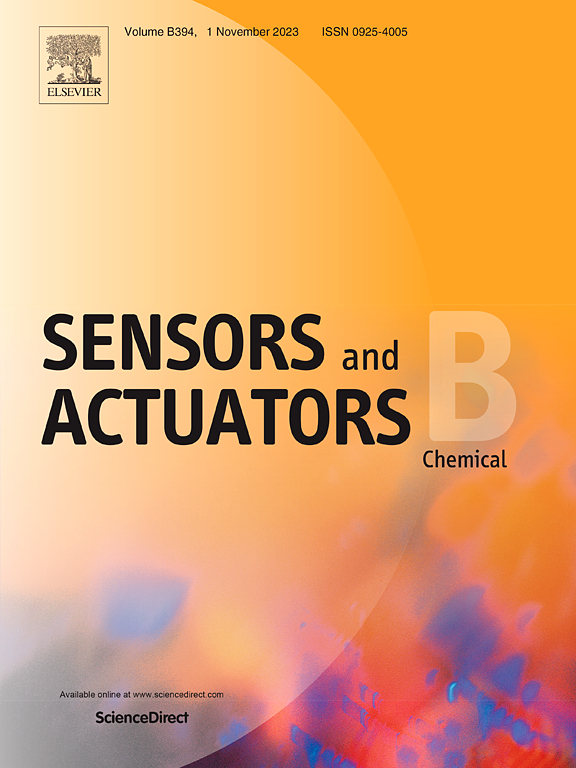CoTsPc辅助聚苯胺功能化Ti3C2Tx MXene气体传感器用于室温下ppb级NO检测
IF 8
1区 化学
Q1 CHEMISTRY, ANALYTICAL
引用次数: 0
摘要
NO的大量排放对人类健康和生态系统都构成重大风险。由于其强烈的反应性和氧化性,传统的NO气体传感器已经不能满足日益增长的应用需求。因此,设计和开发高响应、低检测限、高选择性的室温NO传感器至关重要。本文采用方便、环保的水相合成策略,构建了性能优异的MXene/CoTsPc-PANI气体传感器。它采用多层的Ti3C2Tx MXene作为导电衬底材料,利用π-π和静电双向相互作用将钴(II)四β-磺酞菁-聚苯胺(CoTsPc-PANI)高效组装到MXene基体中。CoTsPc-PANI功能化修饰的MXene导致更快的电荷迁移行为,大量的活性位点和显著的比表面积。特别是,MXene/1.0CoTsPc-0.4PANI传感器在室温下具有极高的NO灵敏度(LOD=45.8 ppb),独特的选择性(对NO2的选择性系数为23.5)和高响应(R(100 ppm NO)分别为MXene, PANI和CoTsPc传感器的244.7%,45,24和31倍)。同时,MXene/1.0CoTsPc-0.4PANI传感器在辅助检测汽车尾气中NO含量方面表现出优异的准确性(与汽车检测站测量的相对误差为6.9%)。最后,MXene/1.0CoTsPc-0.4PANI柔性气体传感器表现出与上述传感器相同的优异NO传感性能(相对误差<;3.0%)。该研究为基于mxene的传感材料的设计提供了新的思路,在汽车尾气NO含量检测和柔性气体传感器中具有潜在的应用前景。本文章由计算机程序翻译,如有差异,请以英文原文为准。

CoTsPc assisted PANI functionalized Ti3C2Tx MXene gas sensor for ppb-level NO detection at room temperature
The massive emission of NO presents a significant risk to both human health and ecological systems. Given its strong reactivity and oxidizing properties, traditional NO gas sensors are no longer able to meet the growing demand for applications. Consequently, designing and developing room-temperature NO sensors with high response, low detection limit, and distinct selectivity is crucial. Herein, a MXene/CoTsPc-PANI gas sensor with excellent performance was constructed using a convenient and environmentally friendly aqueous phase synthesis strategy. It uses a few-layered Ti3C2Tx MXene as the conductive substrate material, and utilizes π-π and electrostatic bidirectional interactions to efficiently assemble Cobalt(II) tetra-β-sulfophthalocyanine-polyaniline (CoTsPc-PANI) into the MXene matrix. CoTsPc-PANI functionalized modification of MXene resulted in faster charge migration behavior, numerous active sites, and a significant specific surface area. In particular, the MXene/1.0CoTsPc-0.4PANI sensor exhibits extremely high NO sensitivity (LOD=45.8 ppb), unique selectivity (selectivity coefficient for NO2 is 23.5), and high response (R(100 ppm NO)= 244.7 %, 45, 24 and 31 times the response of MXene, PANI and CoTsPc sensors, respectively) at room temperature. At the same time, the MXene/1.0CoTsPc-0.4PANI sensor showed excellent accuracy in aiding the detection of NO content in vehicle exhaust (6.9 % relative error to measurements taken at automobile inspection stations). Finally, the MXene/1.0CoTsPc-0.4PANI flexible gas sensor exhibits the same excellent NO sensing performance as the above sensors (relative error <3.0 %). This study provides new ideas for designing MXene-based sensing materials with potential applications in automotive exhaust NO content detection and flexible gas sensors.
求助全文
通过发布文献求助,成功后即可免费获取论文全文。
去求助
来源期刊

Sensors and Actuators B: Chemical
工程技术-电化学
CiteScore
14.60
自引率
11.90%
发文量
1776
审稿时长
3.2 months
期刊介绍:
Sensors & Actuators, B: Chemical is an international journal focused on the research and development of chemical transducers. It covers chemical sensors and biosensors, chemical actuators, and analytical microsystems. The journal is interdisciplinary, aiming to publish original works showcasing substantial advancements beyond the current state of the art in these fields, with practical applicability to solving meaningful analytical problems. Review articles are accepted by invitation from an Editor of the journal.
 求助内容:
求助内容: 应助结果提醒方式:
应助结果提醒方式:


